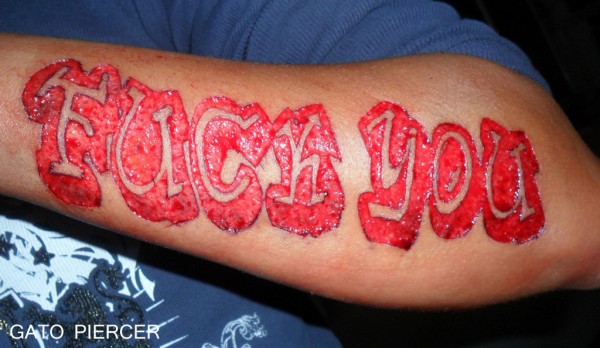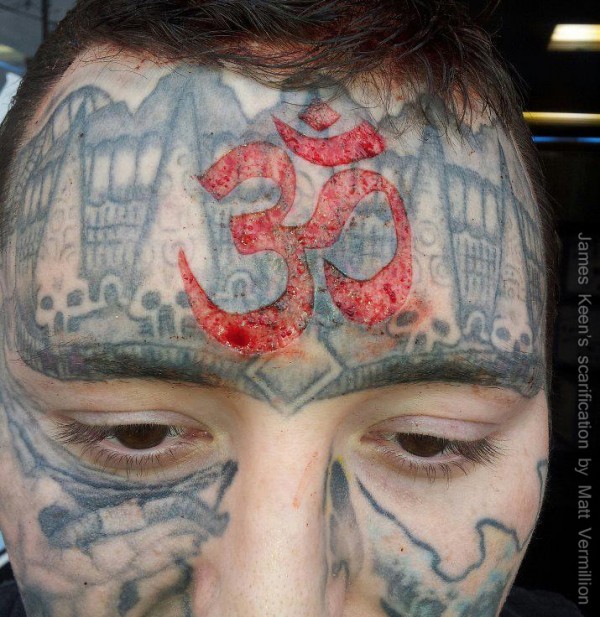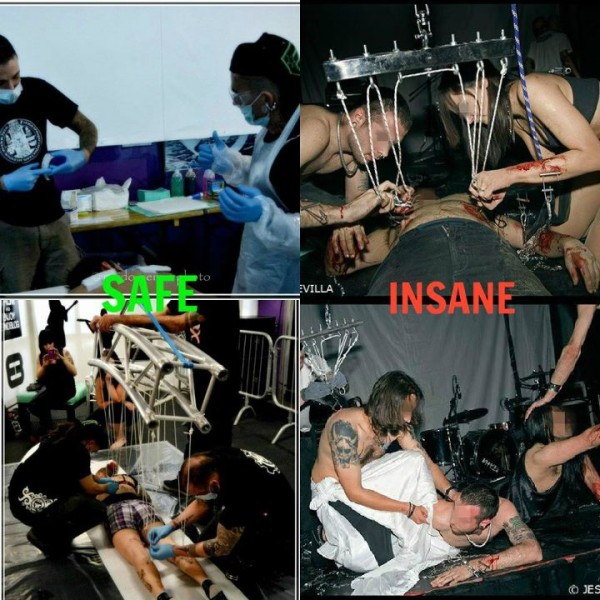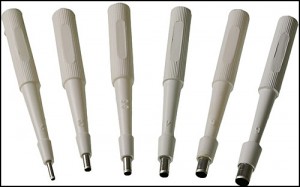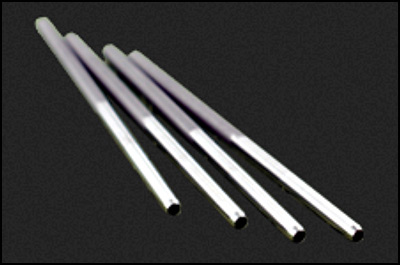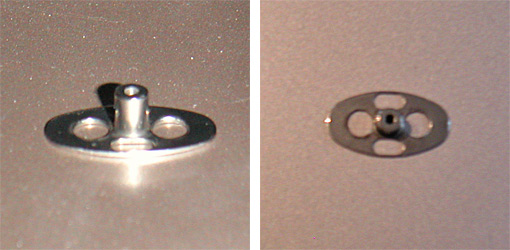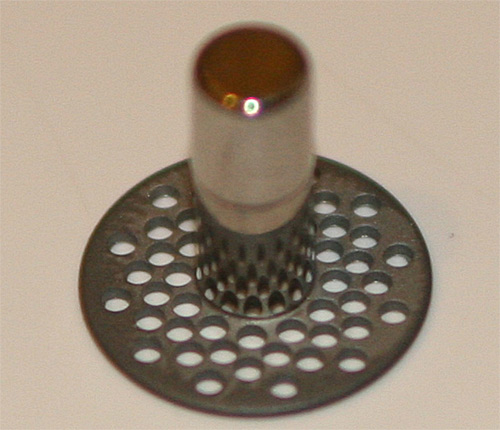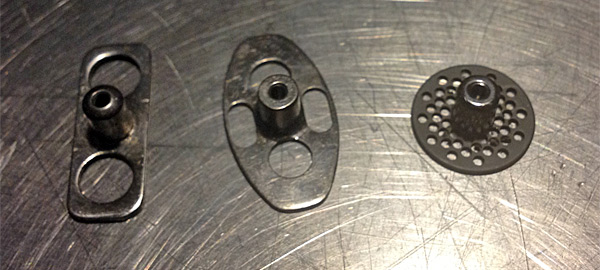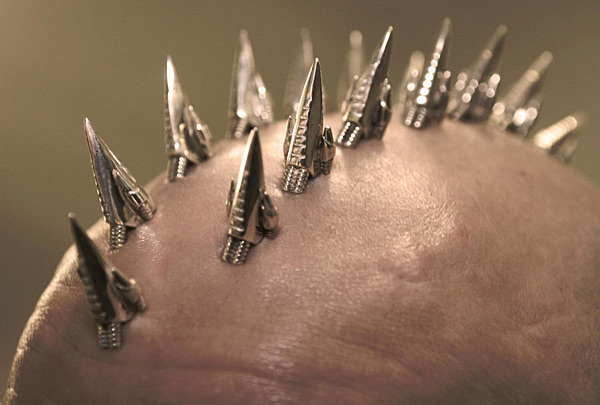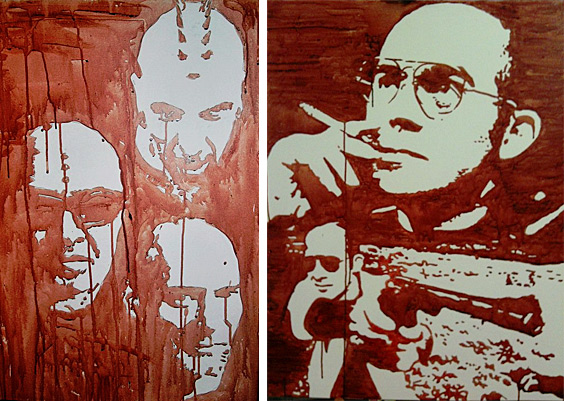Gato Piercer down in Bogota puts my long rambling post about Facebook into a more succinct form in this big graffiti-text skin removal that he carved out over two and a half hours. I have a little worry that some of the lettering (the uncut part in the middle) is going to be overpowered by the scarred outline, making it into a bit of a mushy blur, but if this happens, it could easily be augmented with some tattooing, which would suit the graffiti look I think.
Author Archives: Shannon Larratt
Post navigation
OM silently overpowers the chaos
My old friend James Keen has been on one of the wildest bumpiest body modification adventures over the last decade of just about anyone I know, and even though there have been periods where I’ve been worried about him, he’s kept his head over water, and in time has even become quite the swimmer. His latest piece suits his journey well, a big OM skin removal in the centre of his head, tearing away the deathly tattoos below, the calm unsound of the universe silently singing out over all the chaos below. It was done for him by Matt Vermillion.
PS. I don’t know everyone’s IAM names at this point, so I’m keeping my fingers crossed that one of the other ModBlog writers can help me out with that aspect, or even that readers can add those links in the comments for now.
Facebook is not your friend
I seem to have a history of being blocked and chased off of sites, but I am also rather hard to silence, aren’t I?
A week ago, Rachel was up here in Toronto visiting our daughter, and while she was here I posted the following photo to my facebook wall, which had become a sort of “work safe” ModBlog where I shared the many interesting things that my friends there posted. As you know if you use Facebook, nearly every post or picture or message has a little button that says something like “Report This Photo”. What you may not know is that it only takes a single person clicking it to get your account banned from Facebook, and that there appears to be no human oversight or moderation to this process. Whether that means that it’s completely run by bots or it’s minimum-wage moderators mindlessly clicking “ok” all day long I have no way of knowing — all I know is that the process is broken. Anyway, here is the photo I posted while Rachel was here, the first one that got me in trouble, earning a one day ban for violating “community standards”:
Admittedly, it’s a “boobie” picture, so I’m not terribly surprised that some prude reported it. However, I censored the nipples, and in any case, on Facebook’s “community standards” page they explicitly state that they allow tasteful nudity and artistic nudity. Unforuntately Facebook provides no mechanism for disputing these bans, and even says “don’t bother asking us to lift a ban, because we never do even if it’s in error — just be patient”. There are no forms to contact them about this, so I spent some time reading news articles about similar bans — they’re quite common — and got the name of Andrew Noyes, a Facebook PR guy who’d dealt with this in the past, tracked him to his personal email address, and wrote him a letter asking him to help.
While I waited, I went out for an icecream with my daughter and Rachel and told them what had happened. Rachel went on a bit of a rant about how unfortunate it is that many modification artists are using Facebook as their primary home, because Facebook, to simplify what she said, “is not our friend”. Sure, they’re happy that we’re there posting our pictures and attracting eyeballs to generate advertising revenues for them, but don’t ever kid yourself into thinking they care about this community or will protect it in any way — let alone protecting larger civil rights like freedom of speech or privacy. They’ll do what’s good for their bank account, and that is a very different thing than what is good for the body modification community. Rachel told me that if I ever wanted to have a safe place to blog on the subject, that the doors of ModBlog were open to me. Since I still have a lot of hurt feelings and heartbreak about the way I stopped blogging here in the first place, I said thanks but no thanks, and anyway, blogging at Facebook, even though their platform sucks, is very easy and fast and makes it convenient to network with my friends, and since I’m just doing this just for fun these days I figured I’d stick with Facebook. This decision was solidified by getting an email from Andrew Noyes on my return saying the same throw-away line I’ve seen him use in the media — “It was an error and we apologize for any inconvenience it may have caused.”
But in any case the one-day ban was off six hours later and I figured it was the end of my troubles and continued posting as normal. Everything seemed fine, until I posted the following image, along with a note about health and safety:
Now, before I continue telling my Facebook story, I’d like to put this picture into context, because there is more to it than meets the eye. Yes, of course all things being equal suspension should be treated with the same controls on sterility, safety, and cross-contamination as body piercing is. That goes without saying, and I can’t imagine there isn’t a person who disagrees. However, to speak by analogy, just because you agree that all things being equal people should wear condoms when having sex, it does not follow that you believe long-term partners must wear condoms, or that condoms are required in erotic art (aka pornography). If the photos on the “insane” half of the photo are in an artistic context between fluid-sharing partners, or people who are otherwise “safe” to contaminate each other’s blood, then the lack of gloves carries with it less additional risks and becomes more of a political issue than a safety issue (and of course with the free flowing blood on the practitioners in the top-right photo, gloves alone would not be an adequate precaution). Of course one could say “but what if someone copies that”, but really, my stance has always been that it is the job of BME — and people in general — is to educate and provide all available information, not to censor themselves for fear that people will blindly emulate without understanding the risks.
I’ve been talking to the performers in the bottom right photo, and I should mention first that they are artists, and not a suspension team — they do not suspend others. Everyone involved was tested for disease, and in any case, two of them are married partners. This was an art performance. It was not a suspension event. So the above montage at least in part compares apples and oranges — and while no one disagrees with the general message, it does it using the the wrong illustration, and thereby unfairly hurts people who are not part of the problem. Let me finish off this diversion by sharing with you the beautiful video of the performance so you can understand it in context, and perhaps take away the lesson that if you’re going to create an image like this (and there are many floating about), you should be very sure about the shots you include:
Human Installation III “Sacrifice” Performance art by Kyrahm from KYRAHM on Vimeo.
But in any case, I went out to a movie (myself watching Total Recall, and my daughter watching Wimpy Kid) and when I came back, I found that I was blocked from Facebook for this post “violating their community standards”, this time for three days. I have written to Andrew Noyes again, but unfortunately this time he has not — at least yet — stepped up to help. Now, I don’t believe Facebook specifically has it in for me, or for body modification. I think they simply couldn’t care less about us one way or the other, leaving us at the mercy of automated systems that boot us off or slap us with petty punishments the second some complains. I have been speaking out against rebloggers who simply repost pictures they steal from BME as their own, and I have been speaking out against tattoo blogs that objectify women needlessly — for all I know one of them is laughing all the way to the bank, having found an easy way to manipulate the system. Well, they’ve managed to push to somewhere that they can’t censor me. For now, I’m taking my writing to hear on ModBlog. Tattoo artists and piercers beware — all it takes is your competition making a few mouse clicks, and you’ll go through the same hell. Make sure you have a backup plan like BME, because, to again state the obvious, Facebook is not your friend.
I don’t have a good picture to go along with it, but the entry that I was about to post (but couldn’t) when I got back from the movie was about Total Recall… so let me share a picture of one of the iconic characters that is in both the original and the very different remake, and a hilariously awesome tattoo based on the final scene from the original.
The art direction and concept work in the movie is where it really shines, and that includes a few scenes of “body modification of the future” (which reminded me of Warren Ellis‘s superb future-mods comic “MEK”). In addition to three-boobed women, as the main character runs through a very Bladerunner-esque dystopian city, we see a tattoo artist working on a backpiece, as the whole thing flickers like electroluminescent wiring. In addition, some people have phones implanted in their hands (which from the surprise some street urchins show, is not yet commonplace among the general public) — we even get to see Quaid cutting it out of himself, pulling it out quite realistically as an implant would be, as it’s being used to track him. Anyway, it’s mostly an action movie and not a lot more, but there were many little details like that I think people here would appreciate.
So yeah… Screw blogging on Facebook. Even if they “fix this”, at this point I have no reason to believe it won’t happen again and again, eventually causing me to lose everything I’ve worked on. So I’m going to put my posts here instead. I’m not sure if I’ll start right away full-force or ease into it, but I can’t pour my efforts into posts that might mysteriously disappear because of some inaccessible behind-the-scenes process at a megacorporation. Finally, I want to say that I’m not here to “take over” ModBlog and I look forward to working with the others posting here and I appreciate having been offered a safe home to share my opinions on body modification, and a place to highlight the things I see and enjoy. Stay tuned I suppose?
P.S. I have kept copies of everything I have posted to Facebook, so since it’s effectively lost in their useless unsearchable interface, if there’s an interest, I may repost some of the “best of” material here so that it is properly archived for the body modification community to enjoy.
Piercing with a Dermal Punch
It’s been a very long time since I’ve written a body modification editorial. I don’t really have time to do it on a regular basis, but after some private discussion on the subject of the assumed illegality of dermal punches — and becoming fed up with fifteen years of legal urban legends on the subject — I felt compelled to expound on this subject.
PIERCING WITH A DERMAL PUNCH:
PRACTICING MEDICINE WITHOUT A LICENSE,
OR ETHICAL BODY MODIFICATION?
There has been a lot of debate over the past two decades over the use by body piercers of dermal punches (more accurately known as biopsy punches, as they are used by doctors to core out pieces of flesh for analysis). Even though at this point virtually all piercers agree that for certain procedures the dermal punch is a superior and safer tool, many American piercers avoid them and have expressed legal concern over the tool being a “Class II medical device” and this potentially putting them at risk of charges of practising medicine without a license or similar prosecution — or to use a more culturally accurate word, persecution.
In short, the essay will make the case that medical labelling is not only irrelevant to the piercing community, but that it is important that it not be a part of the discussion. I will seek to dispel the persistent myth that dermal punches as used by body piercers are a federally regulated device, and make the case that by perpetuating this myth, the piercing industry both cripples progress and creates new legal risk. Please note however that my argument is regarding federal medical device regulations, and that several state and county US jurisdiction may have secondary tool laws specific to body piercing that are directly relevant to piercers. While I feel these laws were created in error and need to be repealed, they are not the subject of this essay.
Before discussing the law, I want to point out the obvious history of the piercing needle. The piercing needle is of course based on the hollow medical hypodermic needle, and is used by the piercing community in one of two forms historically. In Europe and South America, it was common to use a cannula needle, similar to what is used for installing an IV drip, which is a hollow metal needle with a removable plastic sheath. The piercing was done with the two parts together, and once through the body, the metal part was withdrawn, leaving a plastic tube in the piercing. The jewelry was then inserted into this tube, which was then withdrawn, acting like a sort of taper to install the jewelry in the piercing. In the United States and Canada it was more common for piercers to purchase hypodermic needles of the sort that were mounted on the end of syringes to inject medication in a medical or veterinary context. Because these needles contained hubs for mounting on the syringes, piercers would cut off or otherwise remove the hubs prior to piercing, turning them into the simple needles (metal tubes that have a sharp bevel on one end and are flat on the other) that are in common use today.
n time, converting the medical device fell out of favour, and companies began manufacturing piercing needles purely for the body piercing industry. This was for two main reasons — first, to distance themselves from using a medical device and any potential legalities and regulatory issues that might carry with it. Second, to provide a product that was of consistent quality and had a bevel design better suited to the needs of the body piercing community. However, it is important to recognize that the piercing needle’s genesis and nature is objectively a repurposed medical device.
I should also at this point very briefly comment on what are being called “O-needles” or “chamfer needles”. A normal needle has a diagonal bevel, but these have a bevel that runs perpendicular to the length of the needle. It is essentially a biopsy punch without the plastic handle (although a portion of the metal may be textured to act as a handle), just like a piercing needle is a hypodermic syringe needle without the plastic hub. It works like a biopsy punch in that instead of cutting a curved slot, it “cores” out a small circle of flesh, which, as with dermal punches, makes certain piercings such as cartilage work heal faster and with less scarring and other complications by relieving the pressure on the surrounding tissue. As I write this these new “needles” are being made only in smaller sizes (12ga and below) — but even an 18ga punch is superior to an 18ga needle in some circumstances so I’m not complaining! It is my hope that in time they will be available larger, but at the time of this writing, only “medical” dermal punches are available in larger sizes, with 8mm (approximately 0ga) being a popular size for conch punching. While I am very pleased that the piercing industry is beginning to manufacture punches themselves, and all things being equal, I would much rather see us making all our tools in-house, until both deeper market penetration has been achieved and larger sizes are available many piercers are still in the position of needing tools that were ostensibly made by the manufacturer primarily as a “medical device”.
Now, on to the law itself. You can read an overview here:
www.fda.gov/MedicalDevices/DeviceRegulationandGuidance/GuidanceDocuments/ucm070958.htm
A careful reading should make it clear that the majority of these rules have to do with labelling regulations and other issues relevant primarily to device manufacturers. It is not a set of laws discussing the criminal matters of possession or use as one would have for example with opiate-based medications. No requirements are put forward for the possession of these devices, so while you will be charged as a drug dealer for possessing a bottle of OxyCodone without authorization, you face no such charges for possessing a case of dermal punches. That said, it is important to again note that some local health board regulations governing piercing may well ban the use of dermal punches, and in those cases their simple possession can affect shop licensing. The FDA however makes no such federal ban.
While it is true that the legal definition of the use of dermal punches, scalpels, or piercing needles to perform the procedures common to body piercing has never been tested in court, it is my strong opinion that none of these, when used in the context of body piercing (implants or tongue splitting may well be a different matter) meets the legal definition of “practising medicine”. As such, it is my opinion that once a “medical device” has been repurposed as a “piercing device”, and is being used in a completely different and non-medical context, that these regulations are no longer relevant. The fact that a needle or a biopsy punch is a medical device is relevant to the manufacturer that sells it to the medical community, but it is not relevant to the piercing community who are not doctors and are not acting as doctors. This statement also holds for the S&M and sex store market, which of course also appropriates medical devices in their own way.
Perhaps it is easier to understand why the use of dermal punches is not per se evidence of practising medicine when we examine other items that are also categorized in the regulations as Class II medical devices. For example, motorized wheelchairs are a Class II medical device, just like biopsy punches. Clearly it is sensible that there be regulations in place governing the manufacture and sale of wheelchairs to the medical industry. However, it does not from that stand that all use of wheelchairs is medical in nature or governed by medical law, or that one can be charged for “practising medicine” due to the possession, use, or misuse of wheelchairs. For example, it is perfectly legal — if a bit foolhardy — to organize a wheelchair racing league. You do not need a medical degree to do this. You do not need to be a paraplegic with a prescription from your doctor for the wheelchair. You do not need medical licensing to be a wheelchair mechanic and repurpose or modify the wheelchairs for racing.
The same applies to dermal punches. It’s only a medical device when you’re using it for medicine. If you want to use it for piercing, then you only need to concern yourself with the piercing regulations. As I said, in some jurisdictions, the piercing-specific regulations deal with these in both positive and negative manners depending on who wrote those regulations, although in most they are not specifically mentioned or restricted. In either case, these are piercing regulations, not medical regulations. Those FDA rules are separate and unrelated. And if you want to put a condom on a dermal punch and violate it in ways I don’t want to know about, that’s your business, and again, you don’t need to be a doctor to do it. Admittedly you may need a doctor afterwards, but that still doesn’t make your initial perverse act with the dermal punch medicine.
I am certain that in the future we will see more tools and techniques leak over from the medical field into body piercing and body modification as a whole. Some of the more popular tools will eventually be manufactured by the body modification industry, but not all of them. This issue does not end when the debate on dermal punches ends, or when “O-needles” effectively dominate the market.
It should now be clear that when piercing professionals worry that they should avoid medical devices such as biopsy punches that by the law, this has nothing to do with the regulation itself. It is solely related to how it is being used. Charges related to the unlicensed practise of medicine are related to the act, not the tool. That is, if you do liposuction using a modified home vacuum cleaner, rather than using appropriate medical tools, you are still practising medicine without a license. However, if you use real liposuction tools in an art installation, it is not medicine. What that means is that when a piercer makes the statement that performing a dermal punch procedure is risking such charges, what the law hears is that they are making the very clear claim that the piercing procedure itself is of a medical procedure. Ipso facto, body piercing can not be done by amateurs and should only be performed by doctors. Clearly this is a self-destructive line of thinking by the piercing community, to say nothing of being objectively incorrect, both culturally and legally — for the past decade or more, there are health boards in nearly every jurisdiction specifically regulating piercing completely distinct from medicine. Obviously piercing and medicine are distinct fields.
One last note on the FDA’s regulations on medical device labelling. Stating the obvious, historically the manufacturers of tools used in piercing have been concerned only with the medical community (since they were medical device manufacturers having their products repurposed without their consent or knowledge) and as such have always complied with the FDA’s medical device regulations. However, now that we are making many of our own implements — both piercing needles of the traditional sort and “O-needles” — the new manufacturers do not comply with any of those regulations, even though they are making tools that are arguably very close to the medical devices we are emulating and appropriating (and could in fact be used in medical procedures such as biopsies). I want to urge individual piercers, professional organizations such as the APP, and manufacturers of piercing equipment to be extremely careful about the rhetoric they use calling piercer’s use of dermal punches “medical” or in referring to these tools as “medical devices”. By not stating in the clearest possible terms that “piercing is not medicine” and that tools used by piercers (no matter what the source) are not “medical devices”, we put ourselves at risk of these regulations being unfairly applied to piercers, or more likely, piercing tool manufacturers. We must take care to not allow our caution in avoiding persecution to be used against us in bringing the law down upon us in new and unexpected ways. I feel the best way to do this is by taking a hard-line stance that medical regulations are completely irrelevant and unrelated to the piercing industry, since we are in the business of the ancient art of body piercing, and not that of modern medicine.
So please, let’s drop the fear-mongering. All we do when we promote falsehoods like this is feed into the paranoia of ignorant legislators that may be eavesdropping on our conversations, and use them to write unfair piercing regulations which block piercers from using the best and most ethical tools available to them. For piercing to continue progressing and moving forward, it is important that piercing is not frozen and “locked down”, but that we can innovate and seek out the best possible methods of performing this ancient yet still evolving art form.
The Transdermal Implants of Samppa Von Cyborg
This article is a based on the seminar notes from Samppa Von Cyborg on his transdermal implants, as prepared by Alix Fox. In this abridged form it was edited by Shannon Larratt for public presentation. While parts of this article do discuss procedural techniques, it should be emphasized that this is in no way a “how to” or training of any sort. It is being shared here to help those with an interest and passion for body modification understand the development history of transdermal implants as well as some of the medical and “wearer” issues involved.
* * *
THE TRANSDERMAL IMPLANTS OF SAMPPA VON CYBORG
Influential body modification artist Steve Haworth is credited with inventing the transdermal implant, with the first instance being installed in 1996 as Joe Aylward’s famous “Metal Mohawk”. Four years later, Samppa Von Cyborg began implanting transdermals using posts of his own design. While these procedures were largely successful, the designs left much room for improvement. It is Samppa’s philosophy that even if something works reasonably well, it is crucial to keep researching, reassessing, and redeveloping designs and procedures in order to push body modification innovation forward and always strive strive for better results.
The very first implants that Samppa used were a simple rectangular base onto which a straight post was welded. The primary fault in this style was that no matter how carefully it was made and finished, there remained a welded seam which would not just rub against and irritate the skin, but act as a potential breeding ground for bacteria. To mitigate this, these days almost all transdermals are manufactured (usually by computer controlled tools) out of a single piece of metal.
The other problem with the first style was due not to the manufacturing process, but the actual design. Although the bases were drilled with two holes intended to allow tissue to grow through and anchor the jewelry, the holes were placed several millimetres from the post, leaving a large area of solid metal around the post itself. Since tissue can not adhere to smooth, solid metal, a gap was left through which bacteria could potentially enter the body, leaving the skin irritated — red, sore, and unattractive.
Samppa’s next step was to move to an oval design which attempted to address some of these problems.
The first change was to add more holes in the base, four this time, to anchor this generation of implant more securely. Even though the holes were not identical, they were evenly balanced, resulting in more even growth of scar tissue. The placement of the holes closer to the post bonded the portion of the jewelry actually passing through the skin as snugly as possible, and meant that the pocket of tissue around the base of the post was much smaller and less susceptible to discharge building up inside it.
Over one hundred people had transdermals of this design implanted by Samppa, with great success rates, and these are also what Samppa currently wears in his own Metal Mohawk. Many companies manufacture their own variations and thousands of people have successfully healed transdermal implants of this design generation. Nonetheless Samppa felt there was still room for further improvement, and continued researching and seeking ways to improve healing and longevity and reduce inflammation and complications.
SAMPPA’S THIRD GENERATION TRANSDERMAL IMPLANTS
Many aspects of Samppa’s most recent transdermal implants are based on medical studies, and he emphasizes that the body modification movement needs to pay closer attention to medical research, development, and practises than it currently does. Unlike body modification artists who are rarely wealthy, a gargantuan amount of funding is allotted to medical research, and the testing undertaken is far more precise, thorough, and in-depth than the limited anecdotal results achievable by body modification artists. By paying attention to medical journals and other resources intended for surgeons, mod artists can take advantage of relevant knowledge and advances made by people who work on comparable procedures — albeit for very different reasons — but have much greater access to money and resources (and, perhaps distastefully, are able to occasionally dissect those who they have performed procedures on to examine the body’s response in otherwise impossible levels of detail).
The greatest influence on Samppa’s new transdermal implant design was a series of articles discussing amputees that had been fitted with an ITAP, or “Intraosseous Transcutaneous Amputation Prosthesis” (“intraosseous” meaning that it attached to the bone, and “transcutaneous” meaning it passed through the skin — the latter being the part that was relevant to Samppa’s work on transdermals). In short, an ITAP is a metal post that screws into the patient’s bone, then passes through the surface of the skin to the outside of the body, where a prosthetic can be firmly attached to it. ITAPs can range from small, attaching a prosthetic nose for example, or large, attaching a fake leg and capable of handling the full impact weight of the entire body. Ignoring the part of the ITAP that is screwed to the bone, and you have a device that is very similar to the transdermal implant of the body modification world, with many of the same qualities and issues. By studying advances in ITAP design, Samppa was able to extract crucial information in developing the most sophisticated transdermal implant to date.
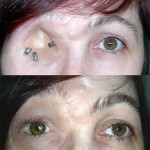
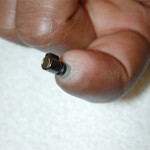
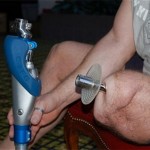
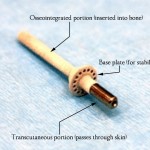
Various ITAP implants created by the medical community.
From left to right: ITAPs used to hold a facial prosthesis in place, an ITAP in a finger, an ITAP in a femur used to mount a prosthetic leg, and a close-up of the ITAP used in an animal experiment.
Samppa’s reading revealed that the medical teams had been inspired by nature — specifically, by looking closely at the horns and antlers of animals. Like ITAPs (and transdermals), horns begin inside the body, pass through the skin, and protrude outside the body. However, animals do not suffer infections or irritation around their horns as can happen with humans with transcutaneous devices or jewelry. The researchers found that the two key factors were porosity — horns are full of many tiny holes into which a network of fine tissue fibres could grow into and root securely — and roughness — below the surface of the skin, the rough surface texture of the horn made it easier for tissue to adhere.
Samppa sought to apply these design features to his new transdermals, pictured below:
Every single element of the design was carefully considered, the result being a revolutionary new transdermal design which represents a significant step forward for the body modification industry. Some of the elements are as follow:
1. BASE FINISH
Much of the initial theories about transdermals were based on experience with body piercing. In body piercing, you want the jewelry to have a surface as smooth and highly polished as possible in order to move about and slide through the pierced hole without tugging — no adhesion of either the body or bacteria to its surface, which also makes it easier to clean. Without really thinking about it, at first most assumed that transdermals should have the same mirror finish, but the reality is that the last thing you want is for the base to move and slide around — you want to encourage adhesion rather than discourage it! Samppa therefore theorized that it made more sense to make the base rough, allowing tissues to get a better grip on it and anchor it in place more firmly. This is exactly like the subcutaneous part of an animal’s horn, and applies the same principle as used in the ITAP. Additionally, if you have ever seen a complete human tooth, you have probably noticed that the upper (exposed) part of it is smooth, which helps it stay clean, but the root is rough, in order to allow the gum tissues and skull to get a good grip on it and keep it held tight in your jaw.
The manufacturers of ITAPs experimented with making their implants rough by applying a textured layer of bioactive hydroxyapatite, a calcium mineral that makes up a significant percentage of bone and tooth. However, for the body modification world, this is difficult to achieve and prohibitively expensive, to say nothing of carrying with it some long-term risk of flaking off of the metal. Instead, Samppa chose to give the implant a rough textured finish using a technique similar to sandblasting.
2. BASE PERFORATION (HOLES)
The most visibly obvious change in Samppa’s new design is that instead of a small number of large holes, he uses a large number of small holes. The ITAP development team emulated horn by peppering their subcutaneous anchoring plates with multiple 0.7mm diameter holes. Due to a tooling constraint, Samppa uses a similar configuration but with 0.8mm holes — behind the scenes, this had to do with the difficulty in finding a manufacturer that had the complex machinery required to make these items, but was also willing to make them in small quantities at a reasonable price. Samppa is currently working with Barry Blanchard of Anatometal, one of the oldest and most experienced body jewelry manufacturers in the wold, to create the new transdermals.
These tiny holes allow tissue to grow through the plate and hold it firmly in place. Their even spacing encourages even tissue growth, resulting in implants which are held straight and true, unlikely to bend or wobble or shift if they are knocked or pushed — unlike transdermal implants of earlier generations. As with the second generation design, placing the holes as close as possible to the post creates a neat, closed “seal” around the post, preventing bacterial entry and subsequent infection. The smaller holes also result in the development of finer strands of anchoring scar tissue, which tend to lay flat rather than forming lumps or bumps which are visible as they bulge under the skin, as can be the case when bigger clumps of tissue grow through the larger holes in older implant designs. With these older transdermals it was not uncommon for the base to be visible as an obvious raised area of skin.
3. BASE THICKNESS
The base plate is only 0.6mm (22 gauge) thick, which is thick enough to be strong even when perforated with many holes, but is also thin enough to not create any visible raising of the skin.
4. POST FINISH
Unlike the base of the implant, the post, which travels through the skin and outside the body, is designed to be as smooth as possible, with a mirror finish. First of all, this allows it to be cleaned easily and thoroughly. Bacteria find it difficult to adhere to such a surface, making it more hygienic, as well as more visually appealing.
Secondly, the skin around the transdermal post constantly moves up and down due to the natural swelling and contraction of the skin. Swelling does not occur just after the implant procedure — the area should be expected to swell when the wearer gets hot, after exercise, if they drink alcohol or some drugs, if they are ill, or if the implant is struck and injured. Similarly, it will contract in the cold. Giving the post a smooth mirror finish allows the skin to slide up and down the post without aggravation, chafing, or adherence.
5. POST PROFILE
In addition to a mirror finish being essential to the movement of the surrounding tissue, so is ensuring that the post is straight, and of a consistent diameter along its length. Some artists have designed implants with flared posts, which have a smaller diameter close to the base and gets wider as they exit. Obviously this makes motion more difficult, and can even lead to tissue becoming trapped or squeezed, resulting in discomfort or even circulatory complications. Severe swelling could even put upward strain on the base of the implant, pulling it away from the body. Flared posts can also prove more difficult to clean, trapping dirt, debris, and bacteria. Posts of this flared design also require a larger hole to be made to implant them, meaning that part of their length will initially be surrounded by an open wound, which is highly undesirable. For these reasons, Samppa’s transdermals have a post of uniform diameter.
6. POST LENGTH
It is crucial that transdermal posts are long enough to comfortably allow for the natural swelling and contraction of the skin. If a post is too short, flesh could swell right over the top of it, or rub uncomfortably against the rim. Samppa’s design includes posts that are available in 4mm, 5mm, and 6mm in length, even though almost all of the other transdermals currently on the market have posts that are 5mm or less. Posts need to be appropriately sized for the thickness of the skin. Using posts that are too short are unlikely to allow for successful, comfortable healing, let alone an aesthetically pleasing result, and can force a shallower placement than is appropriate. Metal Mohawks usually require 6mm posts, with other parts of the body typically being more suited to 4mm or 5mm.
7. POST DIAMETER
At times, again extrapolating from body piercing knowledge, attempts have been made to produce “large gauge” transdermals — that is, transdermal implants with a thick diameter post. It is Samppa’s reasoning that this is a bad idea, because not only are they likely to be heavy and thus harder for the flesh to support, but they will create a larger channel for bacteria to enter the body — to say nothing of leaving a messy wound should they have to be removed. He strongly urges that if you want the “large gauge look” that you simply attach larger ends to the standard jewelry, which he manufactures with 4mm posts (6 gauge).
The reason Samppa settled on 4mm is that it is an ideal size that is both as small as possible, yet robust enough to stay in place and comfortably bear the weight of any attached jewelry. The reason smaller is better is that the smaller the post is, the smaller the potential channel for access to the inside of the body by bacteria is. History has shown that the average transdermal lasts between two and five years — after that they are removed either due to damage, scar tissue, migration, or simply the wearer tiring of them. Samppa’s Metal Mohawk is now eight years old, but it, along with some of his other older implants will be removed within days of this article’s publication, after which they will be replaced with his newer designs.
8. SINGLE-PIECE TITANIUM CONSTRUCTION
While almost all transdermals currently on the market are being made out of a single piece (to avoid seams which irritate tissue and harbour bacteria) using CNC equipment, some manufacturers are still using stainless steel. Stainless steel contains a tiny amount of nickel, which can leave a blue-coloured deposit in the skin over time, and is not as biocompatible as implant-grade titanium.
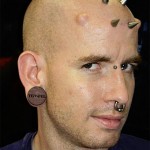


A few of Samppa’s transdermal implant clients.
THE PLACEMENT OF TRANSDERMAL IMPLANTS
Not all problems that people have experienced with transdermals are due to design flaws — proper placement is also essential in ensuring good healing. The prevailing thinking among body modification artists has been that transdermal implants should be placed within the skin layers, as a piercing would be, but Samppa maintains (and he has used this placement from the very beginning) that the correct placement is for the base to rest completely underneath the skin. In the case of the scalp this means resting lightly against the bone of the skull — although it should be noted that the metal does not damage the bone because it there is still a layer of scar tissue between the bone and the metal, padding it — and in other areas it might mean resting lightly against the muscle. This allows for the implant to anchor properly.
One of the reasons that many artists place transdermals too shallow is due to a case in which a man with transdermal implants in his scalp suffered a life-threatening infection, resulting in erosion and loss of a significant portion of the bone in the area. At the time some maintained that this was due to the implant being placed too deep, but Samppa believes that in this case the infection was exasperated by improper implant design making it easier for bacteria to gain access to the body, coupled with inattention to the condition of the implant’s health.
Samppa has been using and monitoring his ITAP-inspired transdermal implants since July 2011, a number of them being done on clients with prior experience with his earlier implant designs. All have reported that the new implants heal faster, with less irritation and a lower incidence of infection. They are also much more securely anchored to the body, which is both a good thing and a bad thing. On one hand it means that they sit straight and true, are unlikely to reject, and can carry much more weight, but on the other hand, if they are struck, they will transfer much more force inward, unlike a transdermal or microdermal which sits only in the skin and thus is incapable of transferring significant force inward.
THINGS TO KNOW BEFORE GETTING TRANSDERMAL IMPLANTS
- Getting transdermals will affect your lifestyle. For example, if you get implants in your head, you’re not going to be hitting any more soccer balls with your head, and if you ride a bike or motorcycle, you will need to adapt the helmet (you may need to use additional foam to build a recess to fit the implants into). There are many subtle and not-so-subtle ways that the implant will affect your life — due consideration and forethought is essential.
- No matter how well placed and designed the implants are, it is not natural for your body to have a metal-filled channel providing access to microbes. Even after they are well healed, it is possible that you will find yourself getting yearly infections in the implants. These infections should not be ignored and will need to be treated.
- It is likely that at some point in the future — most likely between five and fifteen years — you will need or choose to get the implants removed. Think about the fact that you are contemplating at least two surgical procedures.
- It is important to be in the best possible health before your modification appointment in order to increase the likelihood of fast, trouble-free healing.
- If your implants are visible, be prepared to have people approach you all the time. The majority will ask you the same questions over and over, and some of them will be negative. If you can’t cope with this type of public attention, transdermals may not be right for you.
THE TRANSDERMAL IMPLANT HEALING PROCESS
(Using a Metal Mohawk to illustrate — other locations have their own similar but unique issues).
- Immediately after your Metal Mohawk is finished, your head will be swollen and sore. You may experience headaches as the flesh tightens during healing (ibuprofen is helpful).
- About a week later you may suffer from black eyes or puffy eyelids that feel heavy. This is due to the body producing excess lymph fluid around the implants, which drains down the face before dispersing throughout the body via the lymphatic system.
- It is important that you change your pillowcase every two days to ensure that your head is not resting on a contaminated surface while you sleep. Until the wounds and stitches heal you may see a small amount of blood on the cloth in the morning.
- Although most transdermals appear healed in two to four weeks, the actual internal healing process takes much longer — approximately one year. The healing can be “a bit of a roller-coaster”, with the implants looking fine one day, and bleeding for no apparent reason the next. It is extremely important that you monitor your body, be self-aware, and seek help immediately if you suspect anything is wrong. Do not forget the story of the individual who let an infection fester until it had eaten a one inch hole in his skull, exposing the brain, even though the skin above it was intact and looked normal.
- You may experience some hypertrophic scarring during the first year, which can make the skin around the transdermal look like raw meat or a blister. Treating it with a paste made of crushed aspirin and sterile water can help reduce this.
- During the first year of his healing, and for nearly five years afterwards, Samppa wore large, wide spikes. These were not only fashion — he believes that they helped the healing by slightly compressing the flesh to help the forming scar tissue stay flat, as well as acting as a covering that protected the point at which the transdermal passed through the skin from debris and dirt. The compression also helps to drain discharge out of the pocket around the implant.
CARING FOR YOUR TRANSDERMALS LONG-TERM
- As mentioned above, minor infections are not uncommon even in the best-healed transdermals that are kept scrupulously clean. Be conscious of the signs your body gives you and do not ignore them. These signs include redness, itching, heat, irritation, and puffiness. When they occur, Samppa recommends “Orange Easypiercing Spray” (a European mild anti-bacterial solution with active ingredients including alcohol, chlorhexidine digluconate, sodium hydroxide, citric acid, and BHT — similar products are available all over the world). He also screws smooth straight extension bars onto the posts in case of any swelling. If the infection has not disappeared within a week, or gets worse, a prescription for oral antibiotics should be obtained.
- If you need to approach your doctor for antibiotics, be aware that they may never have seen transdermals before, may not understand how they work, and consequently may misinterpret the nature of your infection. There is a very good chance that may overreact and advise that the implants be removed. Alternately, they may prescribe a topical cream to treat surface irritation that will do little to deal with any deeper infection or may even make it worse. It is important that you stand your ground and insist on oral antibiotics to treat the infection. That said, if you or your doctor are seriously worried, you should be willing to go to the hospital without delay. In addition, any reputable body modification artist, whether they have worked on you or your implants or not, should be willing to advise you and give you their opinion.
- In some cases the injectable liquid antibiotic Rifamycin can be of use. It should be applied by sliding the needle down the side of the transdermal post and injecting the solution just beneath the skin so it can act directly on the affected area. It should go without saying that this should only be done by those with appropriate experience and training.
- When travelling abroad, it may be difficult to see a doctor if you need to (and you may incur excessive costs in doing so), yet this is precisely when an infection is most likely due both to the stress of travelling and to the fact that you are being exposed to foreign bacteria that your body is not used to defending against. When travelling you should always endeavour to bring both straight extension bars and oral antibiotics with you.
- Wear extension bars when you fly, because the change in air pressure can cause your skin to swell. The extension bars ensure that the flesh is able to move freely and smoothly around the implants.
- Take care to clean your transdermals thoroughly after swimming — especially in freshwater lakes which have the highest level of bacteria, but in pools and ocean as well. Sterile saline solution is best for cleaning, and this is especially true when travelling since tap water will contain local bacteria that your body has not adapted to.
- This may sound silly, but don’t forget that a Metal Mohawk increases your height! Take care not to bang your head. Also, be vigilant around drunks, who have a tendency to grab or touch your unusual body modification — their intentions may be innocent, but an inebriated stranger whacking your implants is bad news!
- The jewelry that threads into the implants does not enter the body, so it is not essential that it be made of implant-grade titanium like the transdermal. As long as it is not too heavy and you’re not allergic to the material, you can wear nearly anything you’d like. However, because it still comes in close contact with your skin, if you plan to wear it for a long period of time, hypoallergenic, high-grade materials are always recommended. Additionally, wearing rubber O-rings around the base of the transdermal is not recommended. Even though they may look good and seem to hide any scar tissue, rubber or plastic next to the skin increases sweating, which can attract grime and bacteria.
- When the implants are finally removed, it is not as simple as reversing the procedure. Any incisions must be made following the skin’s Langer Lines (the direction in which the collagen fibres lay) to minimize scarring, and all scar tissue within the body needs to be excised before the wounds are sutured.
For more information, media requests, or to order jewelry or make an appointment to have transdermal implants done, please contact Samppa Von Cyborg c/o [email protected]
THIS DOCUMENT MAY BE REPRINTED IN FULL SO LONG AS IT IS NOT ALTERED AND NO INFORMATION IS CHANGED, ADDED, OR REMOVED.
* * *
Finally, as this article goes to print, Samppa Von Cyborg is setting out on a European Tour, offering not just transdermal implants, but magnetic implants and other implants (silicone skull implants, tiny ear implants, and more), tongue splitting, flesh stapling, ear pointing, repair of piercing scars and ear reconstruction, and all other forms of body modification — as well as educational seminars and blood painting! Again, get in touch via [email protected]
Samppa can also be found on Facebook at http://www.facebook.com/voncyborg
The current dates for the European tour are as follows:
London, UK == 11th – 15th July
Paris, France == 15th – 18th July
Gruyere/Lausanne, Switzerland == 18th – 24th July
Lyon, France == 24th – 25th July
Freiburg, Germany == 26th July – 1st August
Mannheim, Germany == 1st – 4th August
Krakow, Poland == 5th – 15th August
Berlin, Germany == 15th – 22nd August
Hamburg, Germany == 22nd – 23rd August
Copenhagen, Denmark == 24th – 29th August
Amsterdam, Netherlands == 29th August
Haarlem, Netherlands == 30th August – 1st September
Belgium == 1st – 2nd September (not confirmed yet)
Paris, France == 2nd – 8th September
London, UK == 8th – 13th September (not confirmed yet)
After Europe, the 2012 tour continues into Japan, Brazil, Argentina, Chile, and Puerto Rico, and then in 2013 heads into Australia and March.
Much of this tour is being done by car, so if you live between these cities, please get in touch because it’s easy to stop on the way, even if you live in a small town.
Lighthouse
Well, that’s all for today. You may see more from other writers in the next little while (and of course videos from Roo as always), and if I’m needed over the next few weeks you may see a few more entries from me as well. I really do hope this transition can go smoothly. BME (as in the main site) is in the process of updating in the next 12-24 hours.
As much as BME is absolutely a large-scale community project, for a decade and a half the output has been under my creative guidance and very much flavored by my own personality, politics, and interests. I’m sure there are people who are hoping that character will stay the same, and I’m sure there are people who are hoping it will change radically, and of course there’s value in each path. I am very much looking forward to seeing how things are expressed through a new prism, and I hope everyone gives it a chance.
Either way, I’m also looking forward to being able to get back out to the East Coast — maybe I will bump into John P at Peggy’s Cove, since his ear lends evidence that he’s been there.

Remembering Granny
On some levels, nicer than a traditional portrait, and at least from my point of view, about a gazillion times better than a cross with initials and some dates on it! This bingo-playing memorial was done by Dave at Marked for Life in Warren, Michigan. No, this does not count as a Biohazard post, haters.

Collar Hearts
Cute and simple, Rachel‘s hearts were done by John Deweese at Great American Tattoo Company in Shelbyville, Indiana. I get a kick out of all these tattoos that are inherently linked to youth culture — in the previous generation of tattooed seniors, most people had military tattoos and sailor stuff and the general iconography of adulthood, but it’s going to be different this time around, with most people wearing the iconography of youth…

Una Poema
Since people seem to like the large-scale text tattoos (like the recent Kerouac tattoo, a typo-ridden ‘If’, a Bukowski poem, A Tale of Two Cities, and this big script piece), here’s another… This poem that Avonchorda wears was written by herself and tattooed by Alex at Las Calaveras Body Modification Studio in Cholula, Puebla, Mexico, where she lives. You can see it in full on her IAM page.
Marking The Years
Secret South got the “32″ on his thirty-second birthday, followed by another friend who got his on his 36th birthday, and then another during her 33rd year. Finally, his lover got hers this past Sunday for Mother’s Day during her 34th year. I can make some guesses about their personalities from their individual choices of fonts, but the only thing I can deduce for sure is that Secret South is mature and prefers the company of people older than himself.

